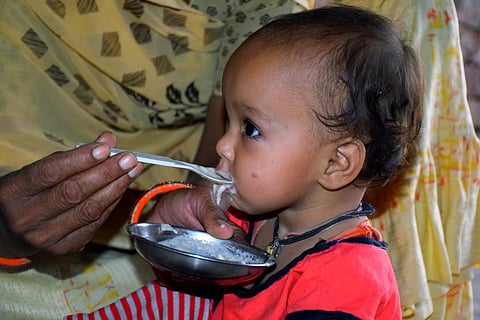

India has ranked shamefully high in a study calculating the prevalence of children aged 6-23 months who have not eaten anything over a 24-hour period, across 92 low- and middle-income countries (LMIC). In absolute numbers, the paper found India had the most ‘zero-food’ children at 6.7 million — almost half of all the zero-food children in the surveys.
Zero-food children are the ones who did not consume any animal milk, formula or solid or semisolid food during the last 24 hours. At approximately six months of age, breastfeeding is no longer sufficient to provide the child with necessary nutrition. Introducing solid or semisolid foods along with breastfeeding is essential for fulfilling the nutritional needs of early childhood, playing a pivotal role in crucial aspects of child growth and development.
With 19.3 per cent ‘zero-food’ children, India was third highest globally after west African countries Guinea (21.8 per cent) and Mali (20.5 per cent). Nigeria had the second-highest number of zero-food children (962,000), followed by Pakistan (849,000).
The research, published in journal JAMA Network Open on February 12, 2024, looked at 276,379 babies aged six to 23 months in 92 LMICs. During this crucial phase of growth and development, children are especially susceptible to undernutrition.
The researchers gathered data from demographic and health surveys (DHS) and multiple indicator cluster (MICS) surveys conducted from May 20, 2010, to January 27, 2022. Of the total sample size, 51.4 per cent of the sample were boys. For India, National Family Health Survey's 2019-2021 data was used.
DHS and MICS surveys used standardised questions on feeding practices, covering common and country-specific solid or semisolid foods. Despite variations, they generally included similar food groups. The analysis treated milk and infant formula as food items, excluding breastfeeding and other liquid feedings, except in a sensitivity analysis.
The combined data showed there were 13.9 million children who had not eaten anything in the studied countries or 10.4 per of the sample. The prevalence of zero-food instances differed by regions, with the highest rates seen in South Asia (15.7 per cent) and west and central Africa (10.5 per cent).
Latin America and the Caribbean had the lowest prevalence and number of zero-food children, at 1.9 per cent, or 120,000 children. East Asia and the Pacific had the second-lowest prevalence, at 2.9 per cent.
The paper read:
Research has demonstrated the short- and long-term benefits of adequate feeding, such as reduced risk of mortality, malnutrition, stunting, underweight and micronutrient deficiencies, as well as improved brain development, cognition and school readiness, laying the foundation for future learning and achievement.
However, more than 99 per cent of the children who experienced zero-food situations had been breastfed, the paper found. This suggests that nearly all these children received some calories even during the 24-hour period when they did not receive other food sources.
High rates of children experiencing zero-food situations in certain countries indicate the necessity for focused interventions to enhance feeding practices for infants and young children. This is crucial to ensure optimal nutrition during a critical period of their development.
Nigeria, Pakistan, Ethiopia and the Democratic Republic of the Congo also showed substantial numbers of zero-food children, emphasising the need for targeted interventions in these countries. Meanwhile, highly populated countries such as Indonesia and the Philippines had relatively many zero-food children, despite relatively lower prevalence rates.
This highlighted the importance of considering both prevalence and absolute numbers when designing interventions, even in countries with apparently lower risk. The researchers also found differences according to household wealth.
There was a noticeable pattern in the prevalence of children experiencing zero-food situations based on their age across different regions too. For instance, in the total sample, 20 per cent of children aged 6 to 11 months had zero food, which decreased to 6.6 per cent for those aged 12 to 17 months and further to 4.1 per cent for those aged 18 to 23 months.
The study pinpointed key areas where policies and programmes can intervene to enhance the nutritional well-being of children who experience zero-food situations. It is crucial to tackle the socioeconomic and environmental factors that contribute to food insecurity, it added.
“Strategies should include enhancing access to nutritious foods, improving maternal and caregiver knowledge about appropriate feeding practices and strengthening health systems to ensure the availability of necessary resources and support. The design and implementation of interventions should be context specific, accounting for cultural practices and local challenges,” the paper read.
The researchers, however, warned that it used data reported by individuals in household surveys. “Parents or caregivers might not accurately remember what the child ate in the 24 hours before the survey, introducing a recall bias that could result in either underestimating or overestimating the prevalence of zero-food instances,” it said.